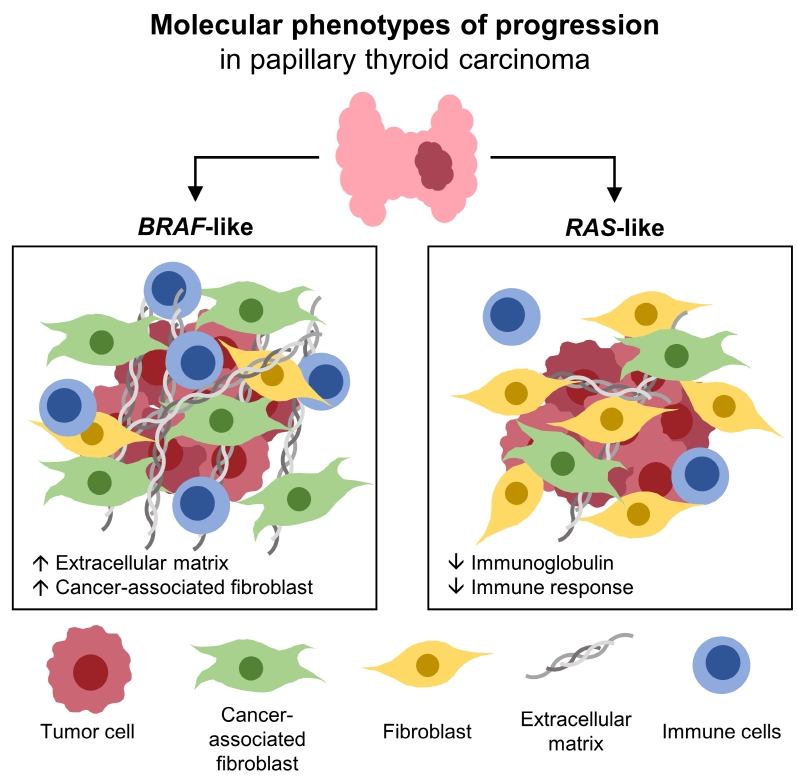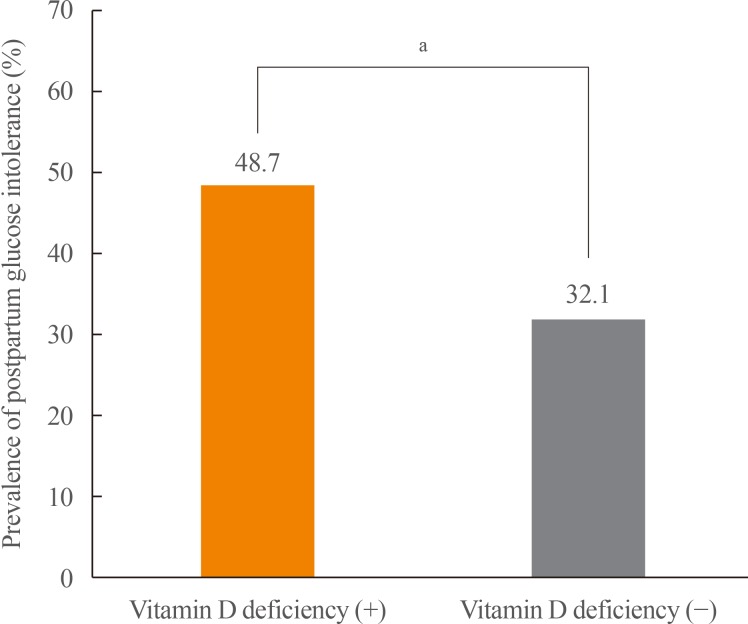Search
- Page Path
- HOME > Search
- Thyroid
- Different Molecular Phenotypes of Progression in BRAF- and RAS-Like Papillary Thyroid Carcinoma
- Jinsun Lim, Han Sai Lee, Jiyun Park, Kyung-Soo Kim, Soo-Kyung Kim, Yong-Wook Cho, Young Shin Song
- Endocrinol Metab. 2023;38(4):445-454. Published online July 18, 2023
- DOI: https://doi.org/10.3803/EnM.2023.1702

- 1,643 View
- 102 Download
-
 Abstract
Abstract
 PDF
PDF Supplementary Material
Supplementary Material PubReader
PubReader  ePub
ePub - Background
Papillary thyroid carcinoma (PTC) can be classified into two distinct molecular subtypes, BRAF-like (BL) and RASlike (RL). However, the molecular characteristics of each subtype according to clinicopathological factors have not yet been determined. We aimed to investigate the gene signatures and tumor microenvironment according to clinicopathological factors, and to identify the mechanism of progression in BL-PTCs and RL-PTCs.
Methods
We analyzed RNA sequencing data and corresponding clinicopathological information of 503 patients with PTC from The Cancer Genome Atlas database. We performed differentially expressed gene (DEG), Gene Ontology, and molecular pathway enrichment analyses according to clinicopathological factors in each molecular subtype. EcoTyper and CIBERSORTx were used to deconvolve the tumor cell types and their surrounding microenvironment.
Results
Even for the same clinicopathological factors, overlapping DEGs between the two molecular subtypes were uncommon, indicating that BL-PTCs and RL-PTCs have different progression mechanisms. Genes related to the extracellular matrix were commonly upregulated in BL-PTCs with aggressive clinicopathological factors, such as old age (≥55 years), presence of extrathyroidal extension, lymph node metastasis, advanced tumor-node-metastasis (TNM) stage, and high metastasis-age-completeness of resection- invasion-size (MACIS) scores (≥6). Furthermore, in the deconvolution analysis of tumor microenvironment, cancer-associated fibroblasts were significantly enriched. In contrast, in RL-PTCs, downregulation of immune response and immunoglobulin-related genes was significantly associated with aggressive characteristics, even after adjusting for thyroiditis status.
Conclusion
The molecular phenotypes of cancer progression differed between BL-PTC and RL-PTC. In particular, extracellular matrix and cancer-associated fibroblasts, which constitute the tumor microenvironment, would play an important role in the progression of BL-PTC that accounts for the majority of advanced PTCs.

- Clinical Study
- Vitamin D Deficiency at Mid-Pregnancy Is Associated with a Higher Risk of Postpartum Glucose Intolerance in Women with Gestational Diabetes Mellitus
- Kyung-Soo Kim, Seok Won Park, Yong-Wook Cho, Soo-Kyung Kim
- Endocrinol Metab. 2020;35(1):97-105. Published online March 19, 2020
- DOI: https://doi.org/10.3803/EnM.2020.35.1.97

- 5,515 View
- 117 Download
- 9 Web of Science
- 8 Crossref
-
 Abstract
Abstract
 PDF
PDF PubReader
PubReader  ePub
ePub Background To evaluate the association between serum 25-hydroxyvitamin D (25(OH)D) at mid-pregnancy and postpartum glucose intolerance in women with gestational diabetes mellitus (GDM).
Methods We enrolled 348 pregnant women diagnosed with GDM from August 2012 to October 2016. We measured serum 25(OH)D levels at mid-pregnancy and carried out a 75-g oral glucose tolerance test at 6 to 12 weeks after delivery. Vitamin D deficiency was defined as serum 25(OH)D <20 ng/mL.
Results The prevalence of vitamin D deficiency was 76.7% (
n =267). Women with vitamin D deficiency had a higher prevalence of postpartum glucose intolerance than did those without vitamin D deficiency (48.7% vs. 32.1%,P =0.011). Serum 25(OH)D level was negatively correlated with hemoglobin A1c at antepartum and postpartum period (antepartum:r =−0.186,P =0.001; postpartum:r =−0.129,P =0.047). Homeostasis model assessment of β-cell function was positively correlated with serum 25(OH)D level only postpartum (r =0.138,P =0.035). The risk of postpartum glucose intolerance was 2.00 times (95% confidence interval, 1.13 to 3.55) higher in women with vitamin D deficiency than in those without vitamin D deficiency (P =0.018).Conclusion In women with GDM, vitamin D deficiency at mid-pregnancy is associated with an elevated risk of postpartum glucose intolerance.
-
Citations
Citations to this article as recorded by- Vitamin D Supplementation for the Outcomes of Patients with Gestational Diabetes Mellitus and Neonates: A Meta-Analysis and Systematic Review
Chunfeng Wu, Yang Song, Xueying Wang, Pier P. Sainaghi
International Journal of Clinical Practice.2023; 2023: 1. CrossRef - Influence of hypovitaminosis D during pregnancy on glycemic and lipid profile, inflammatory indicators and anthropometry of pregnant and newborn
Sara de Figueiredo dos Santos, Paula Normando dos Reis Costa, Thaise Gasser Gouvêa, Nathalia Ferreira Antunes de Almeida, Felipe de Souza Cardoso
Clinical Nutrition ESPEN.2023; 54: 81. CrossRef - Risk factors associated with early postpartum glucose intolerance in women with a history of gestational diabetes mellitus: a systematic review and meta-analysis
Zhe Liu, Qianghuizi Zhang, Leyang Liu, Weiwei Liu
Endocrine.2023; 82(3): 498. CrossRef - Postprandial Free Fatty Acids at Mid-Pregnancy Increase the Risk of Large-for-Gestational-Age Newborns in Women with Gestational Diabetes Mellitus
So-Yeon Kim, Young Shin Song, Soo-Kyung Kim, Yong-Wook Cho, Kyung-Soo Kim
Diabetes & Metabolism Journal.2022; 46(1): 140. CrossRef - Effect of Evidence-Based Diet Nursing on Intestinal Flora and Maternal and Infant Prognosis in Patients with Gestational Diabetes
Ying Jiang, Chunbo Qiu, Yuanping Wang, Bin He, Peng-Yue Zhang
Evidence-Based Complementary and Alternative Medicine.2022; 2022: 1. CrossRef - Vitamin D in gestational diabetes: A broadened frontier
Yu Zhu, Ling Li, Ping Li
Clinica Chimica Acta.2022; 537: 51. CrossRef - The Clinical Characteristics of Gestational Diabetes Mellitus in Korea: A National Health Information Database Study
Kyung-Soo Kim, Sangmo Hong, Kyungdo Han, Cheol-Young Park
Endocrinology and Metabolism.2021; 36(3): 628. CrossRef - Fetal Abdominal Obesity Detected At 24 to 28 Weeks of Gestation Persists Until Delivery Despite Management of Gestational Diabetes Mellitus (Diabetes Metab J 2021;45:547-57)
Kyung-Soo Kim
Diabetes & Metabolism Journal.2021; 45(6): 966. CrossRef
- Vitamin D Supplementation for the Outcomes of Patients with Gestational Diabetes Mellitus and Neonates: A Meta-Analysis and Systematic Review

- Obesity and Metabolism
- Low Serum Testosterone Concentrations in Hospitalized Men with Poorly Controlled Type 2 Diabetes
- Kyung-Soo Kim, San-Ha Kang, Moon-Jong Kim, Soo-Kyung Kim, Yoo-Lee Kim, Won-Keun Park, Seok Won Park, Yong-Wook Cho
- Endocrinol Metab. 2014;29(4):574-578. Published online December 29, 2014
- DOI: https://doi.org/10.3803/EnM.2014.29.4.574
- 3,350 View
- 31 Download
- 6 Web of Science
- 6 Crossref
-
 Abstract
Abstract
 PDF
PDF PubReader
PubReader Our aim was to examine whether serum testosterone concentrations are in fact low in hospitalized men with poorly controlled type 2 diabetes compared with healthy men. In this study, 79 men aged 40 years or older (41 healthy men and 38 men with type 2 diabetes) were included. Total testosterone and sex hormone-binding globulin levels were measured. The average duration of diagnosed diabetes was 10.8 years and the mean glycated hemoglobin value was 10.8%. Total testosterone concentrations were lower in men with type 2 diabetes than in healthy men, after adjusting for age and body mass index (3.83±0.32 ng/mL vs. 5.63±0.31 ng/mL,
P <0.001). In conclusion, this study shows that serum testosterone concentrations are lower in hospitalized men with poorly controlled type 2 diabetes than in healthy men. Therefore, men with poorly controlled type 2 diabetes should undergo further assessment for hypogonadism.-
Citations
Citations to this article as recorded by- Nanoparticles of Costus speciosus Ameliorate Diabetes-Induced Structural Changes in Rat Prostate through Mediating the Pro-Inflammatory Cytokines IL 6, IL1β and TNF-α
Duaa Bakhshwin, Khadija Abdul Jalil Faddladdeen, Soad Shaker Ali, Samar Mohammed Alsaggaf, Nasra Naeim Ayuob
Molecules.2022; 27(3): 1027. CrossRef - Association between testosterone with type 2 diabetes in adult males, a meta-analysis and trial sequential analysis
Jianzhong Zhang, Xiao Li, Zhonglin Cai, Hongjun Li, Bin Yang
The Aging Male.2020; 23(5): 607. CrossRef - Momordica charantia Extract Protects against Diabetes-Related Spermatogenic Dysfunction in Male Rats: Molecular and Biochemical Study
Gamal A. Soliman, Rehab F. Abdel-Rahman, Hanan A. Ogaly, Hassan N. Althurwi, Reham M. Abd-Elsalam, Faisal F. Albaqami, Maged S. Abdel-Kader
Molecules.2020; 25(22): 5255. CrossRef - Olive leaves extract attenuates type II diabetes mellitus-induced testicular damage in rats: Molecular and biochemical study
Gamal A. Soliman, Abdulaziz S. Saeedan, Rehab F. Abdel-Rahman, Hanan A. Ogaly, Reham M. Abd-Elsalam, Maged S. Abdel-Kader
Saudi Pharmaceutical Journal.2019; 27(3): 326. CrossRef - Effects of testosterone supplement treatment in hypogonadal adult males with T2DM: a meta-analysis and systematic review
Jianzhong Zhang, Bin Yang, Wenhui Xiao, Xiao Li, Hongjun Li
World Journal of Urology.2018; 36(8): 1315. CrossRef - RAS and sex differences in diabetic nephropathy
Sergi Clotet, Marta Riera, Julio Pascual, María José Soler
American Journal of Physiology-Renal Physiology.2016; 310(10): F945. CrossRef
- Nanoparticles of Costus speciosus Ameliorate Diabetes-Induced Structural Changes in Rat Prostate through Mediating the Pro-Inflammatory Cytokines IL 6, IL1β and TNF-α


 KES
KES

 First
First Prev
Prev



